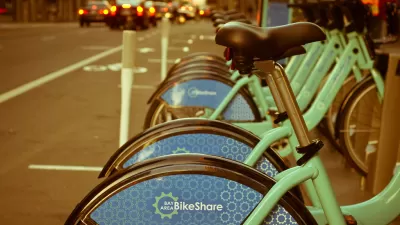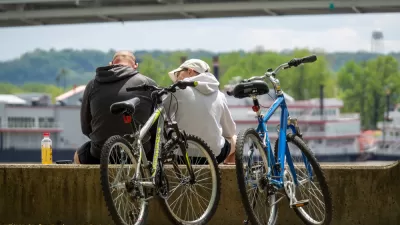Bike counts and bike share rides are increasing in two of the country's largest cities as commuters look for transportation modes that allow for physical distancing.

"A growing wave of New Yorkers are embracing cycling to get to work and around the city as their regular subway and bus commutes have suddenly become fraught with potential perils, from possibly virus-tainted surfaces to strangers sneezing and coughing on fellow passengers," reports Winnie Hu.
The evidence of the surging popularity of bikes as a preferred mode of transportation during a pandemic is more than anecdotal. "Citi Bike, the city’s bike share program, has seen demand surge 67 percent this month: Between March 1 and March 11, there were a total of 517,768 trips compared with 310,132 trips during the same period the year before," reports Hu.
"Cycling has also soared over four East River bridges that connect Manhattan with Brooklyn and Queens, and are popular bike commuting routes. There were as many as 21,300 bike crossings on a single day this month (March 9), up 52 percent from a peak of 14,032 bike crossings for the same period a year ago."
New York City isn't alone. Biking has also surged in Chicago, according to Hu. "Chicago also had a big jump in bike ridership, with its bikeshare program more than doubling to 82,112 trips from March 1 to March 11, from 40,078 trips for the same period last year."
Still, some cities have yet to display similar mobility patterns. In Seattle, for instance, counts along three popular rides have declined. And in San Francisco, the use of bike share has declined.
Returning to New York City, the surge in bike ridership has led to calls for increased bike infrastructure to ensure the safety of the new masses of riders on the streets. According to an article by Gertz Kuntzman, the city has yet to make any choices that reapportion city streets for the benefit of people on bikes during the pandemic.
FULL STORY: A Surge in Biking to Avoid Crowded Trains in N.Y.C.

Planetizen Federal Action Tracker
A weekly monitor of how Trump’s orders and actions are impacting planners and planning in America.

Maui's Vacation Rental Debate Turns Ugly
Verbal attacks, misinformation campaigns and fistfights plague a high-stakes debate to convert thousands of vacation rentals into long-term housing.

Restaurant Patios Were a Pandemic Win — Why Were They so Hard to Keep?
Social distancing requirements and changes in travel patterns prompted cities to pilot new uses for street and sidewalk space. Then it got complicated.

In California Battle of Housing vs. Environment, Housing Just Won
A new state law significantly limits the power of CEQA, an environmental review law that served as a powerful tool for blocking new development.

Boulder Eliminates Parking Minimums Citywide
Officials estimate the cost of building a single underground parking space at up to $100,000.

Orange County, Florida Adopts Largest US “Sprawl Repair” Code
The ‘Orange Code’ seeks to rectify decades of sprawl-inducing, car-oriented development.
Urban Design for Planners 1: Software Tools
This six-course series explores essential urban design concepts using open source software and equips planners with the tools they need to participate fully in the urban design process.
Planning for Universal Design
Learn the tools for implementing Universal Design in planning regulations.
Heyer Gruel & Associates PA
JM Goldson LLC
Custer County Colorado
City of Camden Redevelopment Agency
City of Astoria
Transportation Research & Education Center (TREC) at Portland State University
Jefferson Parish Government
Camden Redevelopment Agency
City of Claremont





























